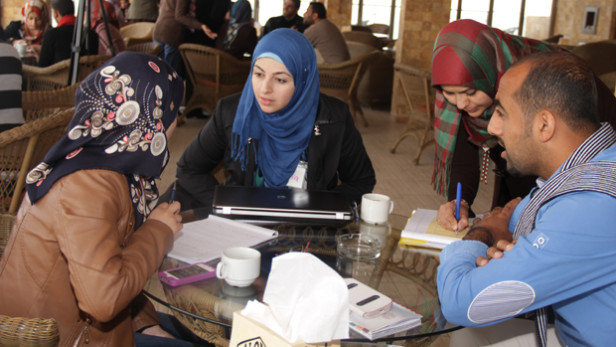
These numbers alone justify the inclusion and consideration of youths in policymaking and planning. But in practice, the meaningful participation of young people in peace building has been hindered by discourses that overwhelmingly depict youths as victims or villains.
Fortunately, recent times have witnessed a gradual shift in paradigm. In a concerted effort to promote youths as active leaders and partners in peace processes, the United Nations, Search for Common Ground, and myriad nongovernmental organizations recently launched theGuiding Principles on Young People’s Participation in Peacebuilding, which offer guidance to key stakeholders on meaningful youth engagement in conflict or transition settings. And as recognition of the positive role youths can play in peace building grows, operational guidelines on how to apply the principles will be published later this year.
So how can organizations leverage youth engagement to uproot violence inherent in their communities and countries? Devex asked four youth activists and experts to share some best practices that development leaders — particularly program designers and managers — can apply to give young people the opportunities they need to become agents of peace.
Create spaces for youths to express their opinions — and listen to them
Rather than simply acknowledging them as victims or perpetrators of violence, it’s vital to engage youths as social actors with their own views and contributions.
“Youth voices in peace building are present everywhere, but sometimes not recognized,” Matilda Flemming, leading coordinator at the United Network of Young Peacebuilders, told Devex. “The creation of spaces for youth to express their opinion to decision-makers and broader society ensures that they have the opportunity to be heard.”
See more stories from #YouthWill Build Peace:
● 3 key ingredients for building a peaceful generation
● Young people leading tomorrow’s change today
● In Libya, a young woman helms crusade for a gender-balanced future
● We must empower and support girls in crisis
● 'Because I was angry'
● 4 lessons on youth and peace building in Lebanon
● My Bangsamoro story: How the youth can take part in building peace
In practice, this can be done by encouraging both youth and adults — parents, teachers, nonprofit workers, or community and religious leaders — to support the formation of youth groups that offer young people a chance to formulate their opinions.
Information and communication technology such as UNICEF’s U-report — a free SMS-based platform through which youths can express their views on what is happening in their communities — also offer some promising spaces of expression for meaningful youth participation in peace building.
Enhance the peace-building knowledge and skills of young people
Although most young peace builders create positive impact with minimal resources, it’s important to provide them with the tools they need to become more effective change-makers.
In concrete terms, this means giving them access to the teachers, facilitators, educational programs and networks that can hone their conflict resolution and leadership skills.
“Training opportunities can range from content-based topics such as conflict or gender to more practical-focused areas such as advocacy or project management,” Dylan Jones, project and gender officer at UNOY Peacebuilders underlined. “By facilitating youth connecting on individual and organizational levels, ideas, challenges and best practices can be organically shared.”
Some of the most successful interventions also find ways to leverage youth interests — arts, sports, media, informal learning and personal relationships — to teach peace-building skills. For instance, Mercy Corps found that youths are more likely to remember conflict management lessons they’ve learned through sports.
Build trust between youths and governments
Youth mobilization in peace-building efforts is more likely to be successful if young people are given the capabilities and opportunities to work with local and national governments.
With few constructive avenues to influence local and national politics, young people tend to view governments as beset by corruption. Conversely, governments often fail to take into account the views of youths in policymaking, and may have different priorities for peace.
To close the gap, activities that promote the legitimization of youths and foster their representation in local and national policymaking processes are crucial, according to Piet Vroeg, child and education director at Cordaid. As such, joint workshops, community projects or platforms can all help bridge the divide between youths and government officials. It’s also important to encourage young people to learn about national or regional peace priorities while helping them work toward their own peace priorities.
As an example, dozens of local youth councils were established in the aftermath of the 2011 Arab Spring revolution in Tunisia — an initiative that has fostered newfound confidence between youths and local politicians.
“Now, after a couple of years, the youth councils have gained the trust of local government authorities, to the point that when it’s time to decide on the local budgets, these youth councils are being consulted to see if the budget make sense,” Saji Prelis, director for children and youth programs at Search for Common Ground, highlighted.
Promote intergenerational exchange
Rather than working with youths in isolation, peace-building projects seeking the engagement of youths should also include parents and elders.
“Young people alone by no means have the answers to the challenges the world and communities around the world are facing. Neither do older generations. By bringing together the vision of young people today, and the experience of older generations, new answers to challenges are created.”
— Matilda Flemming, leading coordinator at the United Network of Young PeacebuildersYouths are deeply influenced by the attitudes of their entourage. Yet adults might perceive youth-led initiatives as a threat to their own power and position. This points to the need for youth peace-building projects to be accompanied by dialogue and cooperation between young people, their relatives and community elders.
“Seek more inclusive means for young people to express themselves and participate in awareness-raising among the wider population,” Vroeg suggested.
Through partnerships with community groups and elder councils, youths can demonstrate the benefits of their peace actions. Such communication and collaboration channels also enable young people and adults to explore the common problems they face and to tackle them together, thus participating in the emergence of sustainable solutions.
“Young people alone by no means have the answers to the challenges the world and communities around the world are facing. Neither do older generations. By bringing together the vision of young people today, and the experience of older generations, new answers to challenges are created,” Flemming underlined.
Strengthen monitoring and evaluation
While efficiencies can always be found, monitoring and evaluation activities need to be undertaken, improved and made routine across all peace-building initiatives capitalizing on youth engagement.
Suffering from a chronic lack of financial support, youth peace-building activities often have very limited ability to evaluate the impact and effectiveness of their work — a situation that seriously impedes the visibility and sustainability of their initiatives.
But beyond increased financial support, innovative approaches to evaluate the impact of youth engagement in conflict resolution must be used — particularly those that build on qualitative evidence and participative approaches.
“Surveys, focus groups and interviews are considered as the gold standard of inquiry, but those are adult methods of articulating evidence and showcasing impact, which ultimately benefit only adults,” Pralis told Devex. “Instead, we should make evaluation conversational and youth-led, as this works for everybody.”
The evaluation process recently started by the Nepal Partnership for Children and Youth in Peacebuilding — a coalition of local youth groups and international organizations — is particularly illustrative. It allows young people to take an active role in determining evaluation design, data collection methods and information analyses.
Support youths who are positively contributing to their communities
Finally, it’s crucial to avoid rewarding “bad behavior” by incentivizing young people who are positively contributing to their communities.
Current youth programming focuses much of its attention on young individuals who were troublemakers or soldiers. This effectively rewards youths for joining armed groups — or is at least perceived as doing so by local communities.
“In general, young people feel marginalized and their voices are not heard or trusted as credible. But when they commit violence, the international community rushes in,” Prelis noted. “We have to be more conscious, cautious and thoughtful in our approach to youth engagement and avoid sending the message that we only care about you when you cause harm.”
Simple rewarding systems such as certificates, prizes and scholarships can serve as great incentives for youth. They can also inspire their peers to take action and participate in peace programs.
Further, try to situate your organization’s programming for young people within larger peacebuilding efforts. Without comprehensive efforts to change the underlying factors that contributed to war in the first place, youths might feel that their efforts are in vain.
Want to learn more? Check out the Youth Will website and tweet #YouthWill.
Youth Will is an online conversation hosted by Devex in partnership with Chemonics, The Commonwealth Secretariat, The MasterCard Foundation and UN-Habitat to explore the power that youth around the globe hold to change their own futures and those of their peers.
Original Source:Devex













